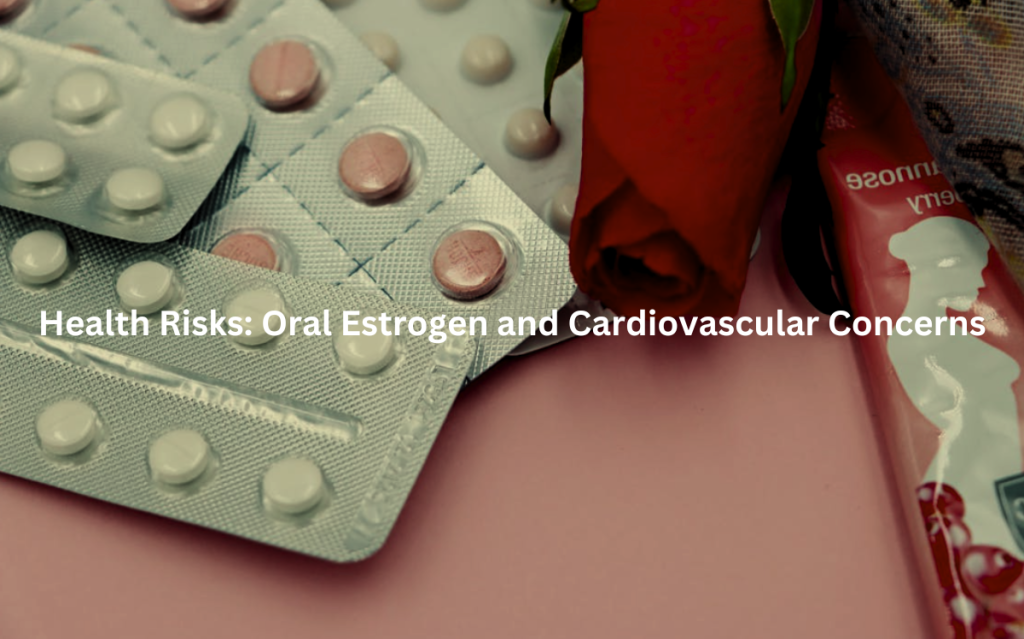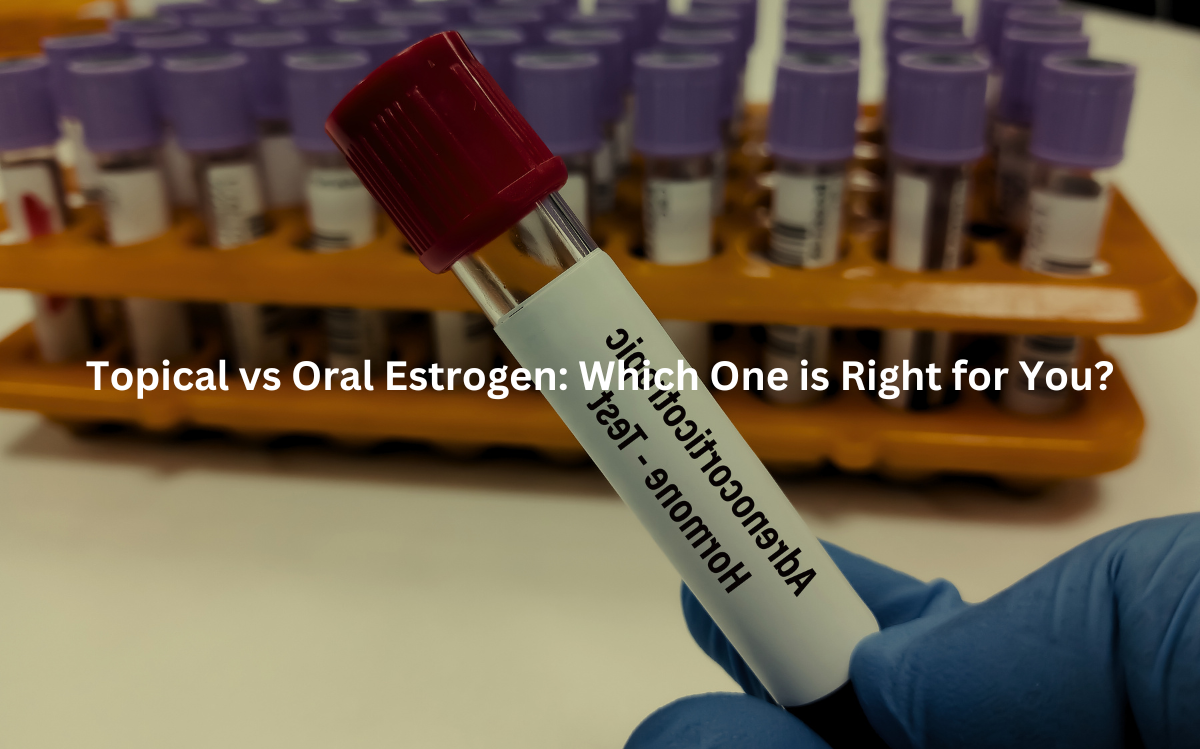Learn the key differences between topical and oral estrogen and which one best suits your health needs.
When navigating hormone therapy, women often face the dilemma of choosing between oral and topical estrogen. Both have distinct benefits and potential risks, especially in managing menopausal symptoms.
Understanding how each option works can help you make a more informed decision, leading to better symptom control and fewer side effects. (1)
Key Takeaways
- Oral estrogen is effective for managing hot flashes and other symptoms but carries higher risks, including blood clots and cardiovascular concerns.
- Topical estrogen (patches, gels) is ideal for reducing risks like blood clots and is effective for localized symptoms like vaginal dryness.
- When choosing between the two, individual health factors such as cardiovascular risk, age, and symptom severity should guide your decision.
Topical vs Oral Estrogen: A Clear Comparison
Estrogen therapy comes in two main forms: oral and topical. The key difference lies in how the hormone is delivered into the body. Oral estrogen, as the name suggests, is taken by mouth, usually in the form of a pill.
Once ingested, it passes through the digestive system and liver before reaching the bloodstream. Topical estrogen, on the other hand, is applied directly to the skin as a cream, gel, or patch, and is absorbed through the skin into the bloodstream, bypassing the liver. This difference in absorption affects how each form works and how it impacts the body.
Oral estrogen is processed by the liver, which can result in a higher risk of blood clot formation and liver-related side effects.
Topical estrogen, due to its direct absorption through the skin, is often considered a safer option for people with a history of liver issues or those at higher risk for blood clots.
While both forms are effective in managing menopausal symptoms, their routes of administration and the way they affect the body differ in significant ways. (2)
Effectiveness of Oral Estrogen for Menopausal Symptoms
Oral estrogen is often the go-to for menopausal symptoms like hot flashes, night sweats, and mood swings. It’s a lifesaver for many women dealing with these issues daily. By replacing the estrogen the body stops making after menopause, it helps control body temperature (bye-bye, hot flashes!) and stabilizes mood swings (thanks, estrogen!).
But, there’s more to consider:
- Effective symptom relief: Oral estrogen works wonders, but it’s not the only option.
- Progestogens: When combined with estrogen, they can reduce risks like endometrial cancer.
- Non-hormonal treatments: SSRIs or gabapentin can ease symptoms but tend to be less effective.
Oral estrogen is often the most effective, but it’s not without its competition. Women should discuss the options with their doctors, adjusting based on what works best for them. It’s all about finding balance.
Topical Estrogen: Benefits for Postmenopausal Women
Topical estrogen is especially useful for women experiencing vaginal dryness and discomfort during or after menopause.
Vaginal estrogen creams or rings can provide localized relief without the systemic effects of oral estrogen. This targeted delivery is beneficial for women who may not need hormone therapy throughout their entire body but require support in the vaginal and urogenital areas.
Topical estrogen has another key advantage over oral forms: it bypasses the liver. As a result, it leads to fewer side effects like bloating, nausea, and headaches that are commonly associated with oral estrogen.
This makes it an attractive option for postmenopausal women looking to manage symptoms like vaginal dryness, urinary tract infections, or painful intercourse, without risking the broader side effects of systemic hormone therapy.
Health Risks: Oral Estrogen and Cardiovascular Concerns

Oral estrogen can help with menopausal symptoms, but it comes with some serious concerns, especially for women with existing cardiovascular risks.
The liver metabolizes oral estrogen, which can mess with clotting factors in the blood. This can increase the chances of blood clots, strokes, or deep vein thrombosis (DVT), a dangerous condition where blood clots form and may travel to the lungs.
Here’s what to consider:
- Risk for cardiovascular issues: Oral estrogen can increase the risk for women with heart disease or high blood pressure.
- Blood clotting: Long-term use raises the risk for venous thromboembolism (VTE), which might lead to a pulmonary embolism.
- Alternatives: Doctors often recommend patches or gels (transdermal estrogen) as a safer option for those with cardiovascular issues.
For women with high cardiovascular risk, oral estrogen might not be the best choice. Monitoring and alternatives are key.
Side Effects of Oral Estrogen: What to Expect
Like any medication, oral estrogen comes with its fair share of potential side effects. Common complaints include headaches, bloating, nausea, and breast tenderness. Some women also experience mood changes, fatigue, and weight gain. These side effects can vary depending on the dose, the individual’s health history, and how their body reacts to the hormone.
Managing these side effects often requires adjustments in dosage. Some women may find that a lower dose of estrogen is effective at controlling symptoms without causing significant side effects. For others, switching to a different form of hormone therapy or incorporating additional medications may be necessary to manage adverse reactions.
Transdermal Estrogen: Reduced Risk of Blood Clots
For women who are concerned about the increased risk of blood clots with oral estrogen, transdermal estrogen can be a safer alternative.
Patches, gels, or sprays deliver estrogen directly into the bloodstream through the skin, bypassing the liver and reducing the risk of clotting. This makes transdermal estrogen particularly suitable for women with risk factors like high blood pressure, obesity, or a history of blood clots.
In fact, studies have shown that women using transdermal estrogen are at a lower risk for developing venous thromboembolism (VTE) compared to those on oral estrogen. This makes it an ideal choice for women who are already at a higher risk of clotting or those who prefer a form of estrogen therapy with fewer systemic side effects.
Estrogen Therapy and Breast Cancer: What the Research Says
The relationship between estrogen therapy and breast cancer is complex. Long-term estrogen therapy, particularly when combined with progestogens, has been associated with a slightly increased risk of breast cancer.
However, this risk is largely dependent on the duration of therapy and the individual’s health history. Women with a family history of breast cancer, those who have had breast cancer, or those with other risk factors may be advised to avoid estrogen therapy altogether.
Some studies suggest that estrogen-only therapy may actually reduce the risk of breast cancer mortality in women who have undergone hysterectomy, as there is no need for the addition of progestogens. Still, the overall risk of breast cancer with estrogen therapy is something that must be carefully considered and discussed with a healthcare provider.
Best Use Case for Topical vs Oral Estrogen
Choosing the right form of estrogen depends on what a woman’s dealing with and her health risks. Oral estrogen is often more effective for those with systemic symptoms, like hot flashes or mood swings, because it works throughout the entire body.
But for women dealing with localized symptoms, like vaginal dryness, topical estrogen (gels or patches) is often a better choice, as it targets those areas directly.
Here’s the breakdown:
- Oral estrogen: Best for overall symptoms affecting the whole body.
- Topical estrogen: Ideal for vaginal dryness or urinary issues.
- Cardiovascular risks: If there’s a history of heart disease or blood clots, transdermal estrogen is usually safer.
Ultimately, a healthcare provider’s advice is key. They’ll help weigh the risks and benefits, based on each woman’s individual health profile and symptoms.
Conclusion
While oral estrogen is often considered the gold standard for managing menopausal symptoms, it’s not without its risks.
Topical estrogen, with its lower risk of blood clots and localized effects, offers an alternative that may be more appropriate for certain women.
The decision between oral and topical estrogen isn’t always clear-cut; it requires thoughtful consideration of symptoms, side effects, and health risks. Ultimately, the best form of estrogen therapy is one that provides the most relief with the least amount of risk for the individual.
Whether oral or topical, estrogen therapy can be a vital tool for women going through menopause. To make the right choice, it’s crucial to fully understand the options available.
Ready to explore your estrogen therapy options? Book a consultation with Modern Menopause today. Book now.
FAQ
What is the difference between topical and oral estrogen?
Topical estrogen is applied directly to the skin in forms like patches, gels, or creams, providing a local effect with less systemic absorption. Oral estrogen, on the other hand, is taken by mouth and absorbed into the bloodstream, affecting the whole body.
Topical forms are often preferred for those at higher risk of blood clots, as they bypass the liver, reducing certain risks associated with oral estrogen, such as increased clotting.
Which type of estrogen is better for managing menopause symptoms?
Both topical and oral estrogen are effective in managing menopause symptoms like hot flashes and night sweats. However, topical estrogen is often recommended for women with a higher risk of blood clots, as it has a lower risk of thromboembolism.
Oral estrogen might be preferred for those who need systemic relief for more widespread symptoms, but individual factors like medical history and risk assessments should guide the choice of therapy.
Are there any risks associated with oral estrogen?
Oral estrogen can carry certain risks, especially for women with a higher risk of blood clots, stroke, or cardiovascular disease.
It is metabolized through the liver, which can increase clotting factors and raise the risk of deep vein thrombosis (DVT) and pulmonary embolism (PE). For women with a history of these conditions or who are overweight, transdermal estrogen (topical) may be a safer option.
Can topical estrogen help with vaginal symptoms during menopause?
Yes, topical estrogen is highly effective in treating vaginal dryness, urinary symptoms, and other urogenital issues during menopause. Vaginal estrogen creams, rings, and tablets are applied locally, minimizing systemic absorption while providing targeted relief.
This makes them a safer option for long-term use, particularly for women with a history of breast cancer or those who are concerned about the risks of oral estrogen.
How do I know which estrogen therapy is right for me?
Choosing between topical and oral estrogen depends on your specific symptoms, risk factors, and medical history.
Women at higher risk for blood clots or cardiovascular issues often benefit more from topical estrogen, while oral estrogen might be more appropriate for those requiring systemic treatment for a broader range of menopause symptoms. A healthcare provider can help assess your individual needs and recommend the most suitable form of estrogen.
References
- https://pmc.ncbi.nlm.nih.gov/articles/PMC10147786/
- https://pubmed.ncbi.nlm.nih.gov/22011208/

Leave a Reply